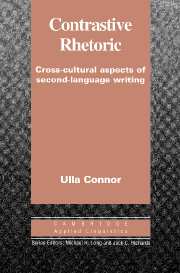Book contents
- Frontmatter
- Contents
- Series editors' preface
- Preface
- I PRELIMINARIES; EARLY PHASES OF THE FIELD
- II INTERFACES WITH OTHER DISCIPLINES
- 4 Contrastive rhetoric and the field of rhetoric and composition
- 5 Contrastive rhetoric and text linguistics
- 6 Writing as an activity embedded in a culture
- 7 Contrastive rhetoric and translation studies
- 8 Genre-specific studies in contrastive rhetoric
- III IMPLICATIONS OF CONTRASTIVE RHETORIC
- References
- Author index
- Subject index
4 - Contrastive rhetoric and the field of rhetoric and composition
Published online by Cambridge University Press: 05 October 2012
- Frontmatter
- Contents
- Series editors' preface
- Preface
- I PRELIMINARIES; EARLY PHASES OF THE FIELD
- II INTERFACES WITH OTHER DISCIPLINES
- 4 Contrastive rhetoric and the field of rhetoric and composition
- 5 Contrastive rhetoric and text linguistics
- 6 Writing as an activity embedded in a culture
- 7 Contrastive rhetoric and translation studies
- 8 Genre-specific studies in contrastive rhetoric
- III IMPLICATIONS OF CONTRASTIVE RHETORIC
- References
- Author index
- Subject index
Summary
In addition to discussing reasons for the importance of writing at the college level in the United States, this chapter describes four major approaches in the teaching of writing: approaches based on rhetorical theories, the expressionist approach, the cognitive approach, and the social constructivist approach. Their influences on contrastive rhetoric in second language writing are assessed.
Contrastive rhetoric research owes much of its current revival to the important role that the teaching of writing plays in undergraduate education in colleges and universities in the United States.
The role of rhetoric and composition in college education in the United States
Historians of composition theory and practice (e.g., Berlin 1987; North 1987) note that the rise of interest in the formal teaching of writing in the United States can be traced back to 1873, when Harvard University first added an English composition requirement to its list of admission standards. The Conference on College Composition and Communication was formed in 1949. Together with other English teachers' organizations, such as the Modern Language Association and the National Council of Teachers of English, this group has brought composition into a central position of interest among English educators.
Beginning in the 1960s, the study of student composing and of written products became a respectable object of academic inquiry. Faculty involved in the research and teaching of writing have gained legitimacy in English departments; writing courses are often taught by tenure-track faculty members, not just by part-time instructors or teaching assistants.
- Type
- Chapter
- Information
- Contrastive RhetoricCross-Cultural Aspects of Second Language Writing, pp. 59 - 79Publisher: Cambridge University PressPrint publication year: 1996



